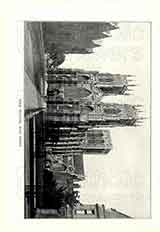

Yellow-Knives, a sub-arctic Deng tribe, called the Copper Indians by Hearne and other early English writers, and Red Knives by Mackenzie and Franklin. To the number of about 500 they range today over the dreary wastes which lie to the northeast of Great Slave Lake. But about a century and a half ago they hunted more usually along the banks of the Coppermine River, to the north of their present habitat. Their name is derived from the knives which they used to make in prehistoric times out of the copper which was found within their territory. This was found scattered on the slopes of a mountain which, at an early date, attracted the attention of the fur-traders on Hudson Bay. This would-be mine occasioned Hearne’s expedition to the mouth of the stream which flowed by the base of the copper-bearing mountain, which has since been known as the Coppermine. According to the national legend of these Indians, this treasure had been shown them by a woman who, having been abused by those who had benefited by her revelation, gradually sank in the ground, and with her disappeared most of the copper. When first met by the whites, the Yellow-Knives were a comparatively bold, quite unscrupulous, and very licentious tribe, whose members too often took advantage of the gentleness of their congeneric neighbors to commit acts of high-handedness which ultimately brought on them bloody retribution. Owing to the segregation forced on them by the nature of their habitat, they have remained one of the tribes least affected by civilization. They are now Catholics, and their spiritual needs are attended to by the Oblate missionaries of two missions lying on the northern shore of Great Slave Lake.
A. G. MORICE

